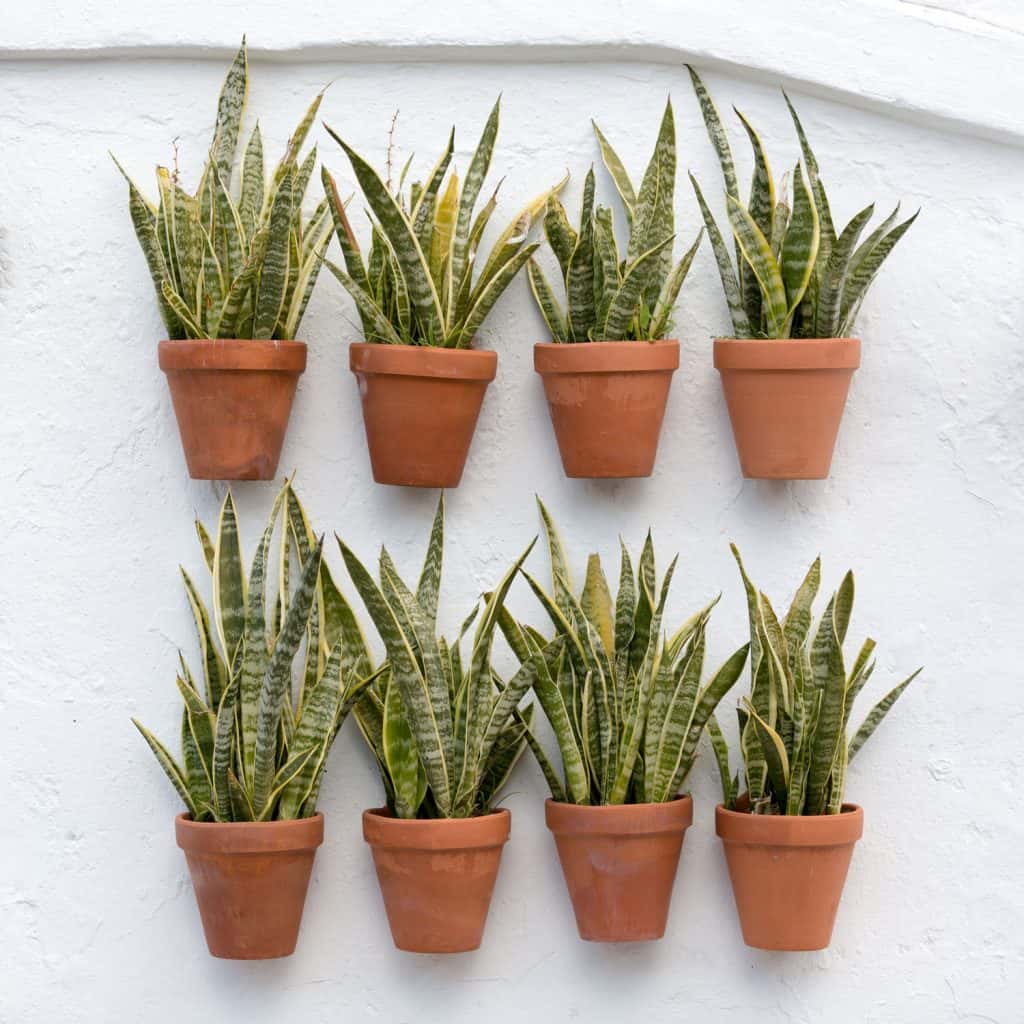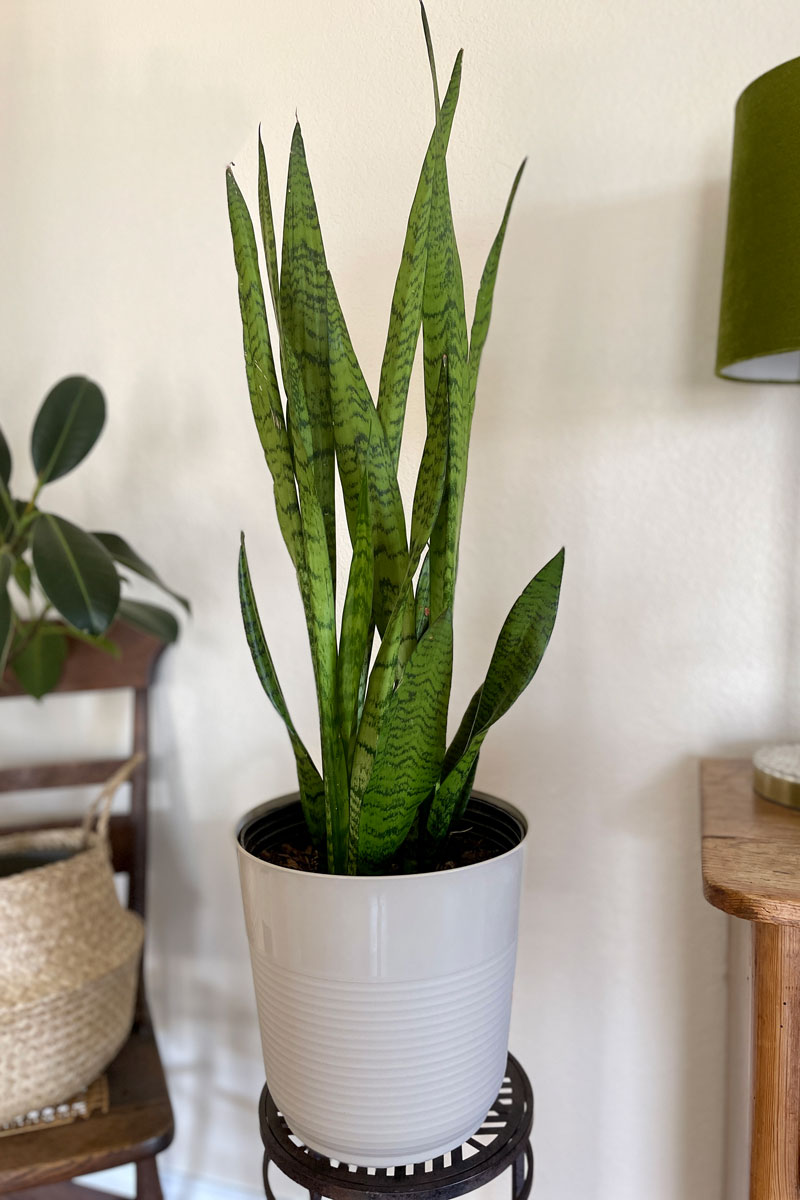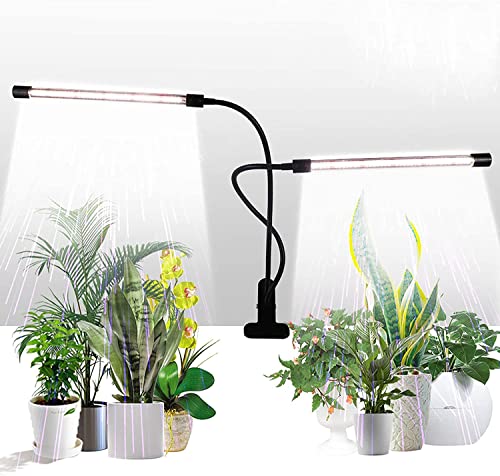Snake plants are nearly indestructible, making them great for people with brown thumbs. But, because they are so easygoing, it can be hard to know where to put them and what kind of care to give. One of the things snake plants are also famous for is their tolerance to darkness. But can they grow well in direct sunlight? We've done the work to bring you the answer.
Snake plants can grow in any level of light. Although they can survive in direct sunlight, you should watch for signs of leaf burn. In general, snake plants do best with at least five hours of indirect sunlight.
In this post, we'll take a closer look at lighting and what your snake plant needs to thrive. We'll also cover some other common questions when it comes to the lighting needs of your snake plant.

Can A Snake Plant Survive Direct Sunlight?
Snake plants, also known as mother-in-law's tongue, are nearly indestructible and perform well when ignored. This makes it great for people who have a tendency to accidentally kill plants.
Snake plants are so hardy they can survive droughts and a ton of other problems, so direct sunlight doesn't bother them too much. Snake plants can survive direct sunlight but tend to prefer indirect sunlight. Direct sunlight may leave snake plants susceptible to leaf burn.

If your snake plant has too much light, they will let you know. If you notice your snake plant's leaves are turning strange colors, usually yellow, brown, or pale, move it a few feet away from the light source.
Leaf burn can sometimes be caused by heat but also overexposure to light. Likewise, if you notice your snake plant is looking a little pale, move it away from the light. Turning pale is usually a sign of overexposure to light in general, not just direct light.
Even if your snake plant develops leaf burn, do not worry too much. Snake plants are hardy and will quickly bounce back from almost any damage. Only in very severe cases will leaf burn cause any long-term damage. Similarly, these conditions will not kill your snake plant.
How Much Light Does A Snake Plant Need?
Snake plants need more than 5 hours of indirect sunlight to thrive. At 5 or more hours of indirect sunlight, they are able to produce enough energy for new growth. Snake plants are very hardy and will survive in low-light conditions. However, without enough light, they will grow very slowly.

No plants can grow completely devoid of light because they need light to create their food. In general, opt to give your snake plants more sunlight than they need.
Low light can also cause the mother-in-law's tongue to grow spindly as its leaves stretch for the light. If you notice your plant is stretching, move it closer to the light source. In general, try to not put them directly in the window. While they will do fine, they will usually do better on a stand or desk next to the window.
Where Should You Place A Snake Plant Indoors?
Because of their easygoing nature, snake plants can be in almost any room. However, it is very popular for them to be in low light rooms like the bathroom or even closets. Ten feet from a west or south window is the best place for a snake plant. This gives the plant enough indirect light without the risk of burning the leaves. If you are looking to place a snake plant indoors, according to feng shui, you have quite a few options. For feng shui, some of the best places to put a snake plant are the entrance, office, or bathroom.
Snake plants have also been known to purify the air, so they are great for any room you spend a lot of time in. Likewise, they will not mind humidity. However, if you put your snake plant in a humid room, make sure you do not accidentally over-water it.
To figure out the best place for your individual snake plant, pick a spot and observe how it is growing. Is it growing slowly? Give it more light. Is it getting leaf burn? Move it further away from the light source.
If you live in a warm climate, you can also grow a snake plant outside. Snake plants will happily grow outside either directly in the soil or in a container.
Can A Snake Plant Grow In A Dark Room?
Snake plants grow well in dark rooms but need at least some light to grow. However, snake plants do not need much light and artificial light can sometimes do the trick. Without light, snake plants cannot do much photosynthesis. So, while darkness may not kill them, they will not grow as fast or as well.

If you have a snake plant in an entirely dark room and wish it would grow a bit faster, move it to a room with more light for a few hours. This method also keeps your snake plant from stretching in a certain direction since you can rotate it when you move things around.
Likewise, if you have a room with no natural light and do not want to move them, you can turn artificial lights on for a few hours. Depending on the kind of lights you have, this may not be particularly helpful but it is better than nothing. While it is not usually necessary, you can get a grow light for your snake plant. This makes it easy to make sure your plants are getting enough of the right light.
Click here to see this grow light on Amazon.
Other houseplants that do well in dark rooms include ferns and spider plants. Both ferns and spider plants also grow well in bathrooms or humid areas. In general, though, try keeping snake plants in their own container. They are hardy and will usually out-compete other plants.
How Do You Know When Your Snake Plant Needs Water?
The most accurate way to test if your plant needs water is to poke your finger an inch or so into the soil. Does the soil feel damp? Wait to water. If it feels very dry, it is time to water your snake plant. If a snake plant develops brown tips, it probably needs more water. However, err on the side of caution since snake plants can go many weeks without water.
Snake plants come from humid and hot areas, but there is some disagreement on if you should mist them or not. In general, if you are prone to overwatering your snake plant, you should probably not mist them. Overwatering is a common problem with snake plants and other succulents. In fact, overwatering is probably the most common killer of snake plants. So, before you water your snake plant, make sure to check the soil first.
Because snake plants like to be a bit root bound, they may be prone to having compact soil. To combat this simply aerate the soil to help the roots have more access to air and water. Compacted soil keeps plants from getting enough air or water, so it can be a big problem. In general, aerating your plants once a year or so is best.

Likewise, snake plants need loose, free-flowing soil to prevent root rot. When purchasing soil for your snake plant, look for sandy soils like those for palms or succulents.
Click here to see this snake plant soil on Amazon.
In Closing
Snake plants are excellent hardy plants that can survive a multitude of conditions, limited light being one of those. And although they can live in many light conditions, they do best when they receive at least 5 hours of indirect light. Enjoy your hardy plant!



